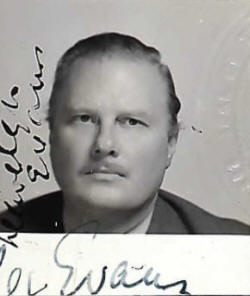Partner Jim Weatherford
Queer Places:
6855 Odin St, Los Angeles, CA 90068
748 1/2 N La Cienega Blvd, West Hollywood, CA 90069
St Peter Churchyard
Slinfold, Horsham District, West Sussex, England
 Rexford Evans (April 13, 1903 - April 3, 1969) was a stout English actor in
The Philadelphia Story (1940, as the butler), The Five Little Peppers films as
Martin the butler, Frankenstein Meets the Wolfman (1943 as Vazec the
belligerent bartender).
Rexford Evans (April 13, 1903 - April 3, 1969) was a stout English actor in
The Philadelphia Story (1940, as the butler), The Five Little Peppers films as
Martin the butler, Frankenstein Meets the Wolfman (1943 as Vazec the
belligerent bartender).
Rexford Reginald Llewelyn Evans was born on April 13, 1903 in Southport, Sefton, England. He attended Marlborough School,
and was a cabaret star during 1920s-30s in London, Paris, New York,
and Los Angeles. Evans moved to Los Angeles in the late 1930s and appeared in several films, including Camille (1936) and the
Philadelphia story (1940); he sold antiques with partner Jim Weatherford and ran custom
shirt-shop and Rex Evans Gallery in Los Angeles.
Close friend of director George Cukor, who frequently cast Evans in his films, often uncredited.
He appeared in ten of Cukor's films, counting Evans' appearance in Cukor's uncredited work on Lust for Life (1956).
Considering the work of classic Hollywood's gay directors and gay
producers, a small but vital subset of the studio system, suggests "queer
cinema" might not be such a modern postulate. Occasionally, a convergence of
director, producer, writer, and star came together, such as happened with
Camille (1937). The gay writer
DeWitt Bodeen said that Camille "represents a meeting of talents
that were perfect for its interpretation." In fact, wags like to call the
picture a rare "all-gay" studio production, and in some ways it comes close:
producer David Lewis, director
George Cukor, screenwriter
Zoe Akins.
Greta Garbo, too, and
Mercedes de Acosta had a
hand in the early draft of the script before Akins took over.
Robert Taylor, who played a
stunningly beautiful Armand, was rumored to be having an affair with the
film's set decorator, Jack Moore. There
was also Adrian on costumes and
Sydney Guilaroff doing hair.
Rex O'Malley infused his Gaston
with a natural feyness, a quality perhaps intended by Cukor and Akins, and
another gay actor, Rex Evans, played
several bit parts. ("Who is that big man and what part is he playing?" Garbo
asked Cukor. "That man is Rex Evans," the director replied, "and he's playing
the part of a friend who needs a job.") Cukor also manuevered the hiring of
another friend, and another gay man, as the picture's true art director,
supplanting the ubiquitous Cedric
Gibbons, whose contract nonetheless decreed screen credit. This was
Oliver Messel, esteemed scenic and
costume designer from the London stage, whose outsider status evoked suspicion
in the competitive world of the Hollywood studios. It wasn't Messel's first
encounter with the studio bureaucracy; in 1935, during the filming of
Romeo and Juliet, Cukor had caused a near war by insisting Messel design
the costumes instead of Adrian, whom Cukor, according to several friends,
viewed as pompous and pretentious. Cukor, as discreet as he was, never tried
to obfuscate either his Jewishness or his gayness in the way Adrian did. "I
get annoyed with statements that call George "closeted",", said his longtime
friend and Los Angeles Times film critic
Kevin Thomas. "George was never
closeted. He never pretended to be anything he wasn't. He lived according to
the rules of his time, that's all."
The Rex Evans Gallery opened as a partnership by Rex Evans and Jim Weatherford at 748 1/2 North La Cienega Blvd., Los Angeles in 1960; during the gallery's years of operation, La Cienega Blvd. became an art center, known for Monday night art walks; the gallery primarily featured works in smaller media of drawings and water-colors; Evans died in 1969, and the gallery closed in 1972.
He died on April 3, 1969 in Glendale, California, USA.
Cremated through Pierce Bros. Westwood in west Los Angeles, the ashes were
sent, according to Westwood records, to St. Peter, Horsham, West Sussex,
England.
My published books:


BACK TO HOME PAGE

- Rex Evans
Papers, (cdlib.org)
- Behind the Screen: How Gays and Lesbians Shaped Hollywood, 1910-1969,
William J. Mann, 2001
- Wilson, Scott. Resting Places: 2 . McFarland & Company, Inc.,
Publishers. Edizione del Kindle.
 Rexford Evans (April 13, 1903 - April 3, 1969) was a stout English actor in
The Philadelphia Story (1940, as the butler), The Five Little Peppers films as
Martin the butler, Frankenstein Meets the Wolfman (1943 as Vazec the
belligerent bartender).
Rexford Evans (April 13, 1903 - April 3, 1969) was a stout English actor in
The Philadelphia Story (1940, as the butler), The Five Little Peppers films as
Martin the butler, Frankenstein Meets the Wolfman (1943 as Vazec the
belligerent bartender). 
